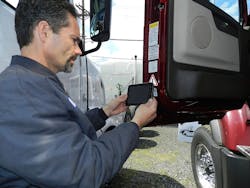CSA violations and fines continue to have a significant impact on fleet operating costs. While there is considerable and justifiable focus on drivers and areas like cargo securement, what you might not know is that over the last two years the Vehicle Maintenance BASIC category has accounted for more than 64% of all CSA violations.
That’s according to reports from Vigillo’s Athena big data business intelligence platform. It’s also backed up by a report in Fleet Owner noting that through last May, the top Maintenance BASIC violations were operating a vehicle without the required operable lamps, followed by citations for out of adjustment brakes.
“The fact that a disproportionate number of CSA violations fall under the Maintenance BASIC,” said Michael Riemer, VP Products and Channel Marketing at Decisiv, “is all the proof you need that drivers either aren’t completing inspections as regularly as they should and/or the information is not getting to or being used effectively by maintenance organizations to promptly rectify identified issues.”
Aligning pre- and post-trip driver inspections with areas that CSA inspectors look for during roadside inspections is a good way to make sure you don’t miss anything important, Riemer noted. “The best defense against CSA violations and fines is to find and fix problems before sending vehicles out on the road, and the best way to do that is with regular and consistent inspections,” he added.
“Electronic Driver Vehicle Inspection Report (DVIR) forms can help,” Riemer continued. “They can be much easier for drivers to fill out quickly and they’re easy to update and change so you can add inspection points for areas that need extra attention. They also provide an audit trail so DVIR compliance can be tracked and you can make sure drivers are completing required inspections accurately and completely.”
Another benefit that Decisiv enables with its Service Relationship Management technology, which 1,200 fleets with 450,000 assets and more than 3,000 service providers are using to perform over 350,000 inspections per year, is that all the information from an electronic DVIR can become part of an asset’s case file. “That means issues identified by drivers during inspections can be part of an repair case or added to a list of items to be handled during the vehicle’s next routine preventive maintenance interval,” Riemer said.
“Another reason to automate the inspection process is that it ensures the right inspection is done on each vehicle based on the correct schedule, no matter where it is being serviced,” Riemer stated. “Whether an inspection is conducted by a driver or takes place in the yard, in the shop or is handled by an outside service provider, when you feed inspection data directly into a closed-loop system you ensure that needed repairs don’t fall through the cracks.”
It’s those cracks that can be costly in terms of CSA violations, downtime and lost asset utilization, repeat repairs, and even rental expenses. Automating the vehicle inspection process leads to well-maintained assets, operating efficiency and productivity, and bottom line profitability.
About the Author
Fleet Owner Staff
Our Editorial Team
Kevin Jones, Editorial Director, Commercial Vehicle Group
Cristina Commendatore, Executive Editor
Scott Achelpohl, Managing Editor
Josh Fisher, Senior Editor
Catharine Conway, Digital Editor
Eric Van Egeren, Art Director
